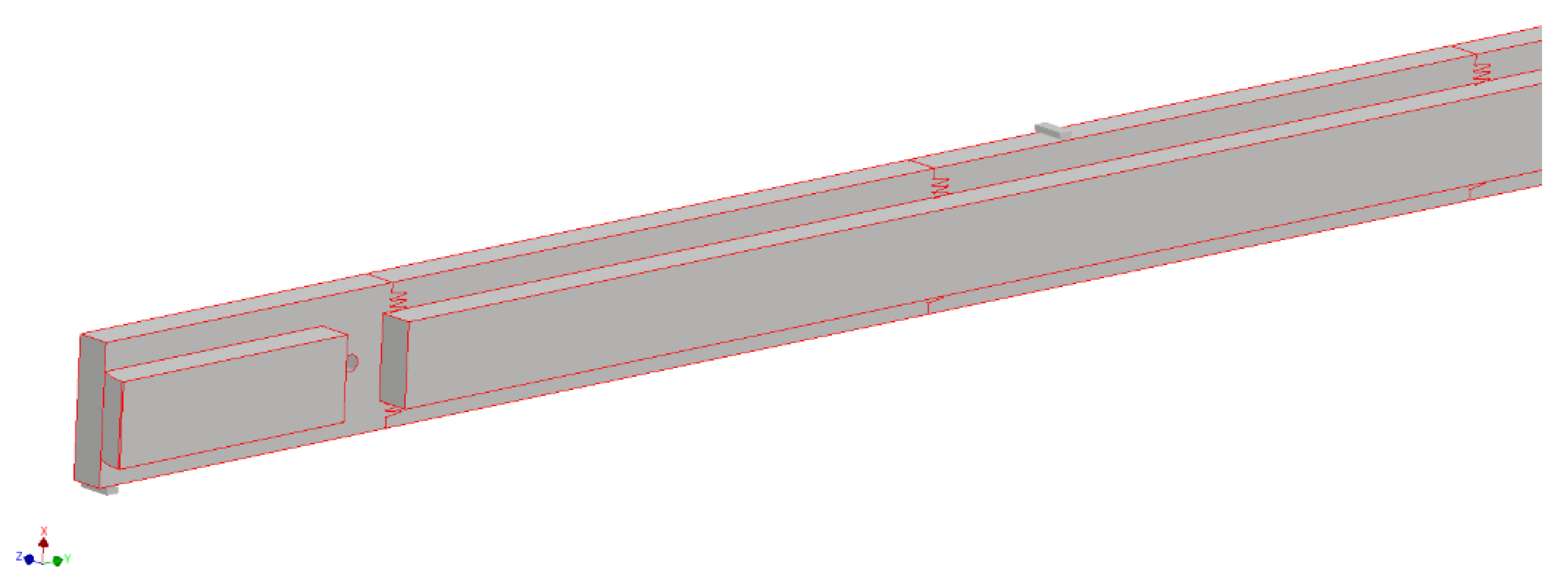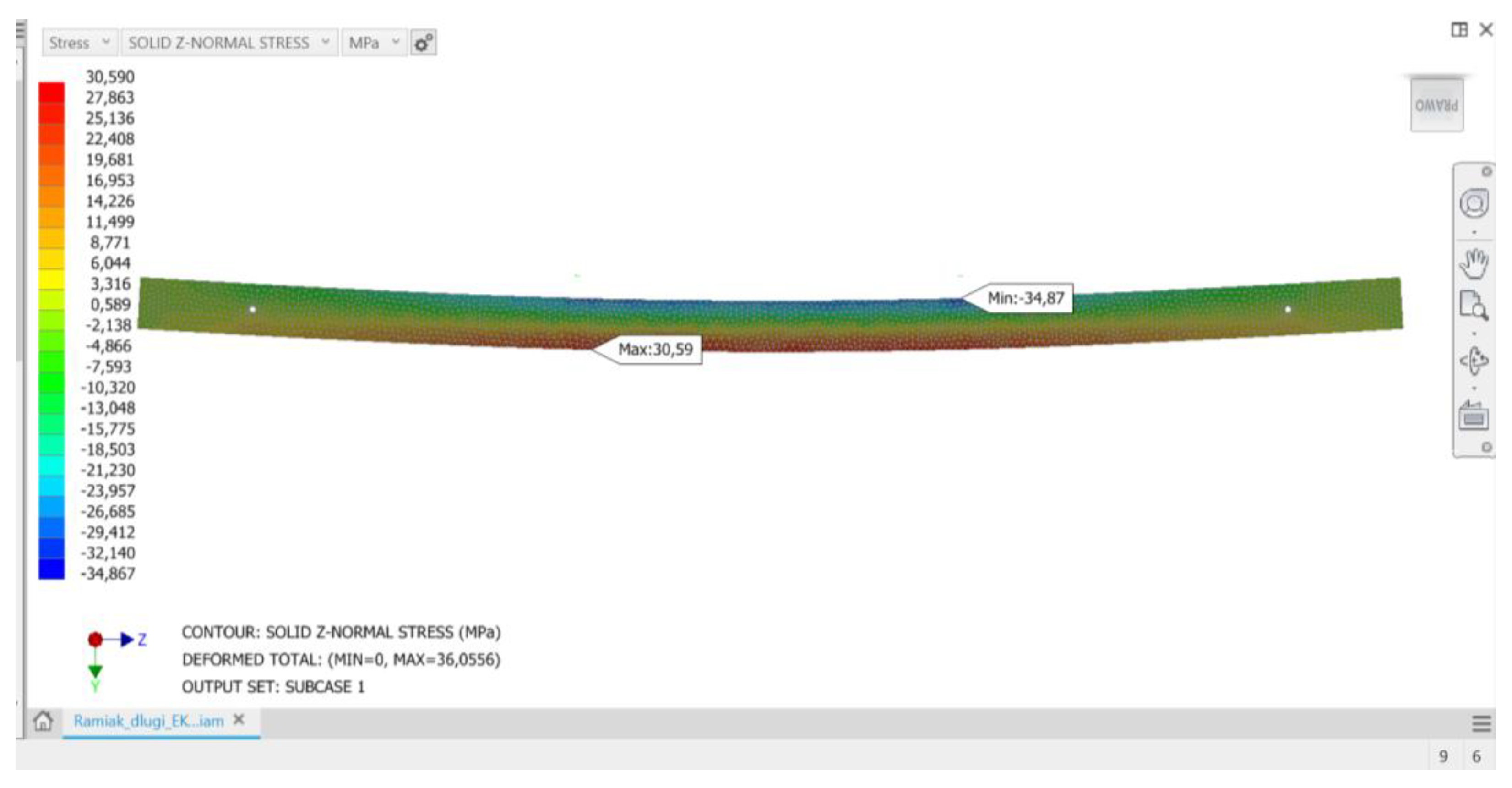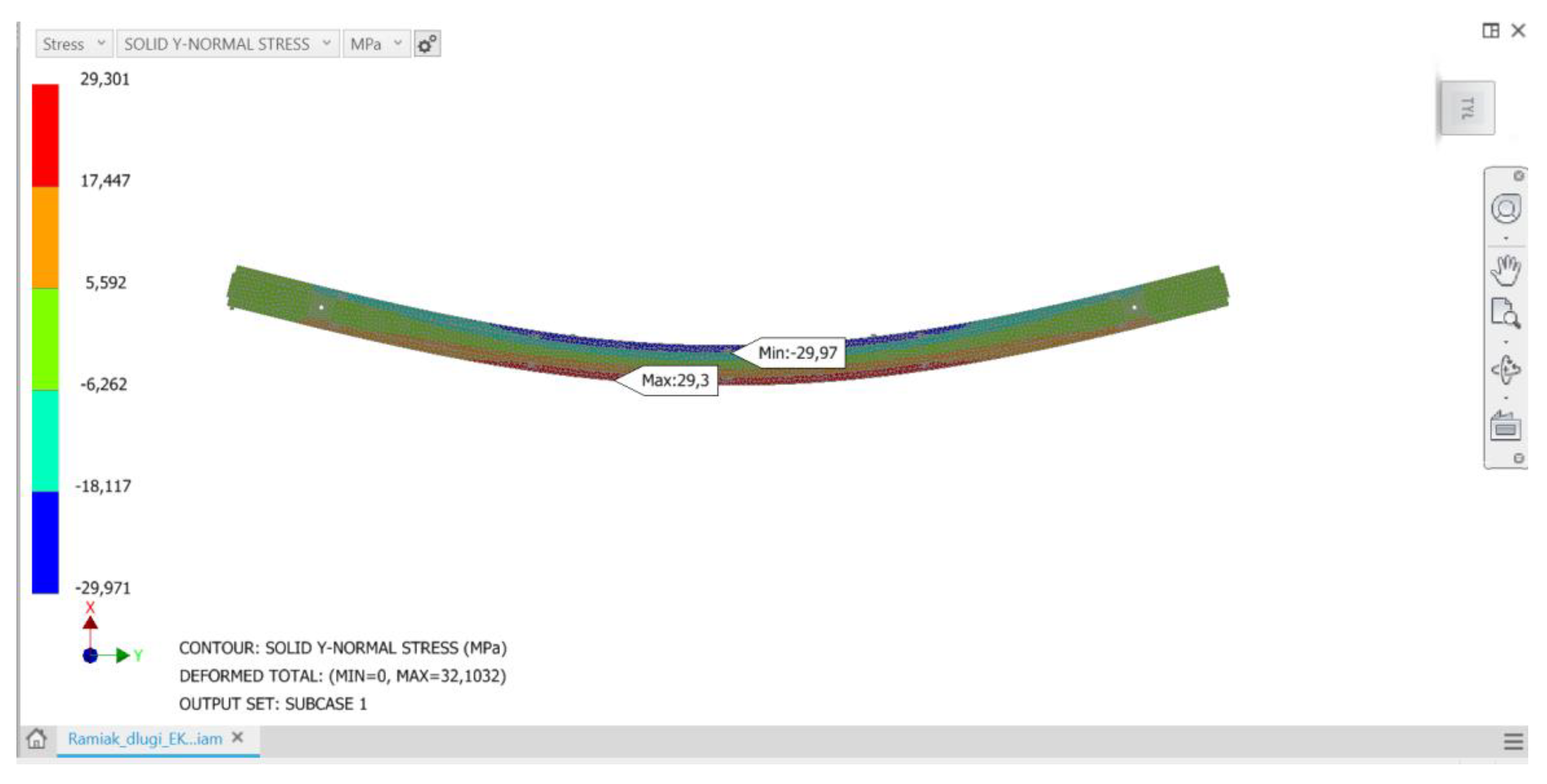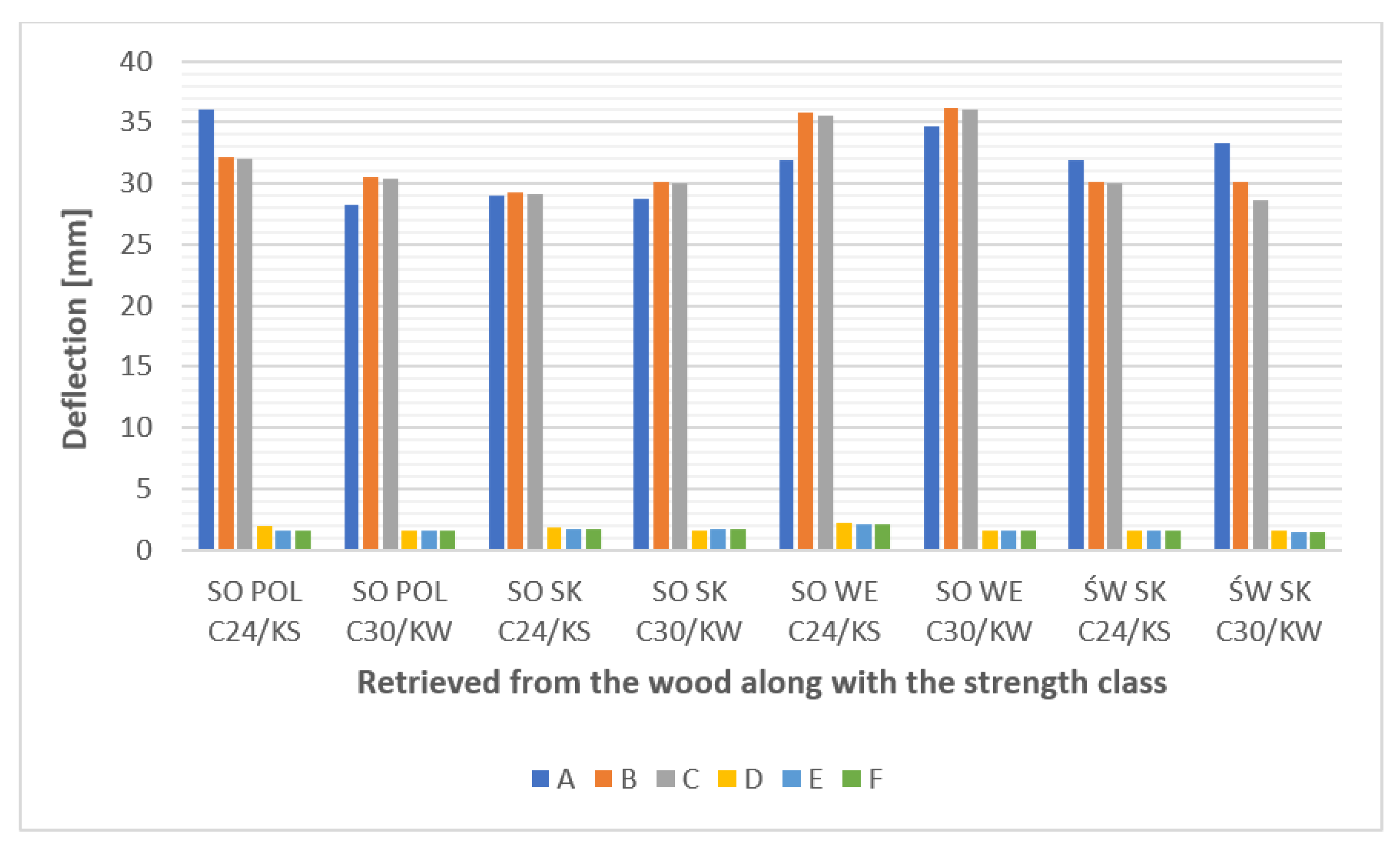Elements of Designing Upholstered Furniture Sandwich Frames Using Finite Element Method
Abstract
1. Introduction
2. Materials and Methods
- a.
- Construction of 3D models of stiles
- -
- Before working in Autodesk Inventor Nastran program on the basis of engineering sketches using Autodesk Inventor, continuous geometric models were developed, i.e., 3D models of the stile structure. Due to the adopted principle of maximum simplification of the geometry of continuous models, dictated by the need to minimize the number of finite elements, the joints (forks) were not shaped in stile models, and also the model was simplified by not introducing the glue joint as an additional element. The elements to be tested are a long frame board, a short frame board, a long frame dovetail, a long frame short dovetail and a short frame dovetail. At the same time, the frame boards have a cross-section of 20 mm × 80 mm, while their dovetails are 20 mm × 48 mm. Due to the adopted research plan, a total of 6 stile models were prepared:
- -
- for long stile, support spacing 1960 mm, thrust spacing 600 mm, thrust distance from the support 680 mm,
- -
- for short stile, support spacing 810 mm, thrust spacing 270 mm, thrust distance from the support 270 mm.
- b.
- Idealization of design
- c.
- Structure discretization
- d.
- Introduction of boundary conditions
- -
- both supports were deprived of all freedom degrees (all translations and rotations—the so-called restraint),
- -
- both thrusts were deprived of their ability to rotate and also slide across the stile,
- -
- in order to achieve convergence (convergence of obtained calculation results) in one contact between the element support and surface, a friction coefficient of 0.5 (static friction coefficient for the steel-wood contact pair) was introduced,
- -
- an external load was applied to the thrust upper surface in the form of a force normal to the surface directed vertically downward with a value of F = 1200 N (total load 2400 N),
- -
- interactions of contacting stile surfaces with supports and thrusts were introduced in the contacting surfaces on the principle of separation-type surface contact,
- -
- interactions were introduced in the contacting surfaces of stile elements on the principle of bonding (without adhesive-bonded joint).
- e.
- Assigning numerical analysis settings
3. Results and Discussion
- -
- maps of the displacement distribution of stile structural elements, counteracting slats, edge of bed, and also the bed frame on the direction of load,
- -
- maps of the normal and or reduced stresses distribution developed in the stile structural elements, counteracting slats, edge of bed, and also the bed frame.
4. Conclusions
- There is no direct influence in the range of normal stresses on the modeling results from the type of coniferous raw material proposed,
- The influence of the form of modification of the element (solid-glued) on the modeling results was not confirmed,
- The stress level is lower when using elements with higher cross-sectional dimensions,
- The stress level is lower for shorter elements,
- Normative stresses do not significantly threaten the strength of the tested elements when the quality requirements of the material used are met.
Author Contributions
Funding
Conflicts of Interest
References
- González-García, S.; Gasol, C.M.; Lozano, R.G.; Moreira, M.T.; Gabarrell, X.; Rieradevall i Pons, J.; Feijoo, G. Assessing the global warming potential of wooden products from the furniture sector to improve their ecodesign. Sci. Total Environ. 2011, 410–411, 16–25. [Google Scholar] [CrossRef] [PubMed]
- Stevens, G.A.; Singh, G.M.; Lu, Y.; Danaei, G.; Lin, J.K.; Finucane, M.M.; Bahalim, A.N.; McIntire, R.K.; Gutierrez, H.R.; Cowman, M.; et al. National, regional, and global trends in adult overweight and obesity prevalences. Popul. Health Metr. 2012, 10, 22. [Google Scholar] [CrossRef]
- Sharapov, E.; Mahnert, K.C.; Militz, H. Residual strength of thermally modified Scots pine after fatigue testing in flexure. Eur. J. Wood Wood Prod. 2016, 74, 875–884. [Google Scholar] [CrossRef]
- Abu, F.; Gholami, H.; Saman, M.Z.M.; Zakuan, N.; Sharif, S.; Streimikiene, D. Pathways of lean manufacturing in wood and furniture industries: A bibliometric and systematic review. Eur. J. Wood Wood Prod. 2021, 79, 753–772. [Google Scholar] [CrossRef]
- Torniainen, P.; Popescu, C.-M.; Jones, D.; Scharf, A.; Sandberg, D. Correlation of Studies between Colour, Structure and Mechanical Properties of Commercially Produced ThermoWood® Treated Norway Spruce and Scots Pine. Forests 2021, 12, 1165. [Google Scholar] [CrossRef]
- Krzosek, S.; Burawska-Kupniewska, I.; Mańkowski, P. The Influence of Scots Pine Log Type (Pinus sylvestris L.) on the Mechanical Properties of Lumber. Forests 2020, 11, 1257. [Google Scholar] [CrossRef]
- Stamatopoulos, H.; Massaro, F.M.; Qazi, J. Mechanical properties of laterally loaded threaded rods embedded in softwood. Eur. J. Wood Wood Prod. 2022, 80, 169–182. [Google Scholar] [CrossRef]
- Rammer, R.D. Wood: Mechanical fasteners. In Encyclopedia of Materials: Science and Technology; Saleem, H., Ed.; Elsevier: Amsterdam, The Netherlands, 2016; p. 3. [Google Scholar]
- Langová, N.; Réh, R.; Igaz, R.; Krišťák, Ľ.; Hitka, M.; Joščák, P. Construction of Wood-Based Lamella for Increased Load on Seating Furniture. Forests 2019, 10, 525. [Google Scholar] [CrossRef]
- Bumgardner, M.S.; Nicholls, D.L. Sustainable Practices in Furniture Design: A Literature Study on Customization, Biomimicry, Competitiveness, and Product Communication. Forests 2020, 11, 1277. [Google Scholar] [CrossRef]
- Sönmez, A. Durability of Varnishes Used on Wooden Furniture Surfaces against Significant Mechanical, Physical and Chemical Effects. Ph.D. Thesis, Gazi University, Ankara, Turkey, 1989. [Google Scholar]
- Percin, O.; Özbay, G.; Ordu, M. Investigation of the mechanical properties of wooden materials laminated with different adhesives. Dumlupınar Univ. J. Inst. Sci. 2009, 19, 109–120. [Google Scholar]
- Di Cesare, M.; Bentham, J.; Stevens, G.A.; Zhou, B.; Danaei, G.; Lu, Y.; Bixby, H.; Cowan, M.J.; Riley, L.M.R.; Hajifathalian, K.; et al. Trends in adult body-mass index in 200 countries from 1975 to 2014: A pooled analysis of 1698 population-based measurement studies with 19.2 million participants. Lancet 2016, 387, 1377–1396. [Google Scholar]
- Jiang, F.; Li, T.; Li, Y.; Zhang, Y.; Gong, A.; Dai, J.; Hu, L. Wood-Based Nanotechnologies toward Sustainability. Adv. Mater. 2018, 30, 1703453. [Google Scholar] [CrossRef]
- Spear, M.J.; Curling, S.F.; Dimitriou, A.; Ormondroyd, G.A. Review of Functional Treatments for Modified Wood. Coatings 2021, 11, 327. [Google Scholar] [CrossRef]
- Dvouletá, K.; Kánová, D. Utilization of anthropometry in the sphere of sitting and bed furniture. Acta Univ. Agric. Silvic. Mendel. Brun. 2014, 62, 81–90. [Google Scholar] [CrossRef]
- Altınok, M.; Örs, Y. Modeling of cross-section and frame optimization for chair design. Turk. J. Agric. For. 1999, 23, 473–479. [Google Scholar]
- Kariž, M.; Tomec, D.K.; Dahle, S.; Kuzman, M.K.; Šernek, M.; Žigon, J. Effect of Sanding and Plasma Treatment of 3D-Printed Parts on Bonding to Wood with PVAc Adhesive. Polymers 2021, 13, 1211. [Google Scholar] [CrossRef]
- Prekrat, S.; Smardzewski, J. Effect of glue line shape on strength of mortise and tenon joint. DRV Ind. 2010, 61, 223–228. [Google Scholar]
- Nicholls, T.; Crissan, R. Study of the stress–strain state in corner joints and box-type furniture using Finite element analysis (FEA). Holz Als Roh- Und Werkst. 2002, 60, 66–71. [Google Scholar] [CrossRef]
- Kasal, A.; Haviarova, E.; Efe, H.; Eckelman, C.A.; Erdil, Y.Z. Bending moment capacity of rectangular mortise and tenon furniture joints. Wood Fiber Sci. 2013, 45, 287–293. [Google Scholar]
- Kasal, A.; Smardzewski, J.; Kuskun, T.; Erdil, Y.Z. Numerical analyses of various sizes of mortise and tenon furniture joints. BioResources 2016, 11, 6836–6853. [Google Scholar] [CrossRef]
- Krzyżaniak, Ł.; Kuşkun, T.; Kasal, A.; Smardzewski, J. Analysis of the Internal Mounting Forces and Strength of Newly Designed Fastener to Joints Wood and Wood-Based Panels. Materials 2021, 14, 7119. [Google Scholar] [CrossRef] [PubMed]
- Tiachacht, S.; Bouazzouni, A.; Khatir, S.; Wahab, M.A.; Behtani, A.; Capozucca, R. Damage assessment in structures using combination of a modified Cornwell indicator and genetic algorithm. Eng. Struct. 2018, 177, 421–430. [Google Scholar] [CrossRef]
- Olhoff, N.; Bendsøe, M.P.; Rasmussen, J. On CAD-integrated structural topology and design optimization. Comput. Methods Appl. Mech. Eng. 1991, 89, 259–279. [Google Scholar] [CrossRef]
- Kasal, A. Determination of the strength of various sofa frames with Finite Element Analysis. Gazi Univ. J. Sci. 2006, 19, 191–203. [Google Scholar]
- Kofod-Petersen, A.; Cassens, J. Modelling with Problem Frames: Explanations and Context in Ambient Intelligent Systems. In Modeling and Using Context. CONTEXT 2011. Lecture Notes in Computer Science 2011, 6967; Beigl, M., Christiansen, H., Roth-Berghofer, T.R., Kofod-Petersen, A., Coventry, K.R., Schmidtke, H.R., Eds.; Springer: Berlin/Heidelberg, Germany, 2011. [Google Scholar] [CrossRef]
- Poux, F.; Neuville, R.; Nys, G.-A.; Billen, R. 3D Point Cloud Semantic Modelling: Integrated Framework for Indoor Spaces and Furniture. Remote Sens. 2018, 10, 1412. [Google Scholar] [CrossRef]
- Smardzewski, J. Numerical analysis of furniture construction. Wood Sci. Technol. 1998, 36, 273–286. [Google Scholar] [CrossRef]
- Altinok, M.; Taş, H.H.; Çimen, M. Effects of combined usage of traditional glue joint methods in box construction on strength of furniture. Mater. Des. 2009, 30, 3313–3317. [Google Scholar] [CrossRef]
- Smardzewski, J. Construction optimisation of upholstred furniture. Folia For. Pol. Ser. B 2001, 32, 5–19. [Google Scholar]
- Zienkiewicz, O.C.; Taylor, R.L. The Finite Element Method, 4th ed.; McGraw-Hil: New York, NY, USA, 1991. [Google Scholar]
- Eckelman, C.A. A technique for structural modeling of front rails for sofas. Euro. J. Wood Wood Prod. 2002, 60, 60–65. [Google Scholar] [CrossRef]
- Li, P. Mechanical analysis for typical mortising joints of wood product with finite element method. Wood Processing Mach. 2010, 25, 13–15. [Google Scholar]
- Smardzewski, J.; Jasińska, D. Mathematical models and experimental data for HDF based sandwich panels with dual corrugated lightweight core. Holzforschung 2016, 71, 265–273. [Google Scholar] [CrossRef]
- Smardzewski, J.; Prekrat, S. Optimisation of a sofa frame in the integrated CAD-CAE environment. Electron. J. Pol. Agric. Univ. 2009, 12, 1. Available online: http://www.ejpau.media.pl (accessed on 10 June 2022).
- Massafra, A.; Prati, D.; Predari, G.; Gulli, R. Wooden Truss Analysis, Preservation Strategies, and Digital Documentation through Parametric 3D Modeling and HBIM Workflow. Sustainability 2020, 12, 4975. [Google Scholar] [CrossRef]
- Kasal, A.; Birgul, R.; Erdil, Y.Z. Determination of the strength performance of chair frames constructed of solid wood and wood composites. For. Prod. J. 2006, 56, 55–60. [Google Scholar]
- Wang, X. Designing, Modelling and Testing of Joints and Attachment Systems for the Use of OSB in Upholstered Furniture Frames. Ph.D. Thesis, University Laval, Quebec, QC, Canada, 2007. Available online: http://archimede.Bibl.unival.ca/archimede/fichiers/24743/24743.pdf (accessed on 10 June 2022).
- Yildirim, M.; Uysal, B.; Ozcifci, A.; Yorur, H.; Ozcan, S. Finite element analysis (fatigue) of wooden furniture strength. In Proceedings of the 27th International Conference Research for Furniture Industry, Ankara, Turkey, 17–18 September 2015; pp. 336–342. [Google Scholar]
- Aboura, Z.; Talbi, N.; Allaoui, S.; Benzeggagh, M.L. Elastic behavior of corrugated cardboard: Experiments and modeling. Compos. Struct. 2004, 63, 53–62. [Google Scholar] [CrossRef]
- Kyuchukov, G.; Marinova, A. Influence of the number and location of stretchers on internal forces distribution in wooden chair frames. In International Association for Technology Management—Wood; University of Zagreb: Zagreb, Croatia, 1999; pp. 119–124. [Google Scholar]
- Marinova, A. Methodology of stress and strain furniture structure analysis. In Proceedings of the International Science Conference “Mechanical Technology of Wood”, Sofia, Bulgaria, 21–22 August 1996; pp. 257–267. [Google Scholar]
- Ostwald, M. Fundamentals of Strength of Materials; Wydawnictwo Politechniki Poznańskiej: Poznan, Poland, 2012. [Google Scholar]
- Markov, I. Finite Elements Method; UASG: Sofia, Bulgaria, 2014; p. 262. Available online: http://uasg.bg/filebank/att_7612.pdf (accessed on 10 June 2022).
- Brol, J.; Nowak, T.; Wdowiak, A. Numerical Analysis and Modelling of Timber Elements Strengthened with FRP Materials; Annals of Warsaw University of Life Sciences, Forestry and Wood Technology: Warsaw, Poland, 2018; pp. 274–282. [Google Scholar]
- Krzosek, S.; Bacher, M. Aktueller Stand Der Maschinellen Festigkeitssortierung von Schnittholz in Polen Und in Europa; Annals of Warsaw University of Life Sciences, Forestry and Wood Technology: Warsaw, Poland, 2011; p. 74. [Google Scholar]
- Lindström, H.; Reale, M.; Grekin, M. Using non-destructive testing to assess modulus of elasticity of Pinus sylvestris trees. Scand. J. For. Res. 2009, 24, 247–257. [Google Scholar] [CrossRef]
- Hossein, M.A.; Shahverdi, M.; Roohnia, M. The Effect of Wood Knot as a Defect on Modulus of Elasticity (MOE) and Damping Correlation. Not. Sci. Biol. 2011, 3, 145–149. [Google Scholar] [CrossRef][Green Version]
- Verkasalo, E.; Leban, J.M. MOE and MOR in static bending of small clear specimens of Scots pine, Norway spruce and European fir from Finland and France and their prediction for the comparison of wood quality. Pap. ja Puu 2002, 84, 332–340. [Google Scholar]
- Bodig, J.; Jayne, B. Mechanics of Wood and Wood Composites; Van Nostrand Reinhold Co., Inc.: New York, NY, USA, 1982; p. 711. [Google Scholar]
- Jyske, T.; Mäkinen, H.; Saranpää, P. Wood density within Norway spruce stems. Silva Fenn. 2008, 42, 248. [Google Scholar] [CrossRef]
- Krzosek, S.; Grześkiewicz, M.; Burawska-Kupniewska, I.; Mańkowski, P.; Wieruszewski, M. Mechanical properties of polish-grown Pinus sylvestris L. Structural sawn timber from the butt, middle and top logs. Wood Res. 2021, 66, 231242. [Google Scholar] [CrossRef]
- PN-EN 1725:2001; Residential Furniture—Beds and Mattresses—Safety Requirements and Test Methods. Polish Committee for Standardization: Warsaw, Poland, 2001.
- PN-EN 338:2016-6; Structural Timber. Strength Classes. Polish Committee for Standardization: Warsaw, Poland, 2016.
- PN-EN 14081-1+A1:2019-11; Wood Structures—Strength Graded Structural Timber with Rectangular cross Section—Part 1: General Requirements. Polish Committee for Standardization: Warsaw, Poland, 2019.
- PN 94021:2013; Structural Softwood Lumber Graded by Strength Methods. Polish Committee for Standardization: Warsaw, Poland, 2013.
- Mirski, R.; Wieruszewski, M.; Trociński, A.; Kawalerczyk, J.; Łabęda, K. Elastic Moduli of Butt-End Logs and the Variable Knots Distribution in Scots Pine from Western Poland. BioResources 2021, 16, 1842. [Google Scholar] [CrossRef]
- Krzosek, S. Timber Strength Grading of Pinus sylvestris L. Using a Visual Method According to Polish Standard PN-82/D-94021 and German Standard DIN 4074. Wood Res. 2011, 56, 435–440. [Google Scholar]
- Wieruszewski, M.; Trociński, A.; Kawalerczyk, J.; Derkowski, A.; Mirski, R. The Strength of Pine (Pinus sylvestris L.) Sawn Timber in Correlation with Selected Wood Defects. Materials 2022, 15, 3974. [Google Scholar] [CrossRef]
- Lukacevic, M.; Kandle, R.G.; Hu, M.; Olsson, A.; Füssl, J.A. 3D model for knots and related fiber deviations in sawn timber for prediction of mechanical properties of boards. Mater. Des. 2019, 166, 107617. [Google Scholar] [CrossRef]
- EN 408:2010+A1; Wood Structures—Structural Solid and Glued Laminated Timber—Determination of Certain Physical and Mechanical Properties. European Committee for Standardization: Brussels, Belgium, 2012.
- EN 1912; Structural Timber—Strength Classes—Visual Division into Classes and Grades. European Committee for Standardization: Brussels, Belgium, 2012.
- Rakowski, G.; Kacprzyk, Z. Finite Element Method in Structural Mechanics; Oficyna Wydawnicza Politechniki Warszawskiej: Warszawa, Poland, 2016. [Google Scholar]
- Stasierski, J. Introduction to the Finite Element Method for Environmental Engineering; Oficyna Wydawnicza Politechniki Warszawskiej: Warszawa, Poland, 2014. [Google Scholar]
- Çolakoglu, M.; Apay, A. Finite element analysis of wooden chair strength in free drop. Int. J. Phys. Sci. 2012, 7, 1105–1114. [Google Scholar]
- Matwiej, Ł.; Skorupińska, E.; Sydor, M.; Wiaderek, K. Strength testing of upholstery frame connections and spring holders. Ann. Wars. Univ. Life Sci.—SGGW For. Wood Technol. 2018, 104, 579–592. [Google Scholar]
- Staneva, N.; Genchev, Y.; Hristodorova, D. Fem analysis of deformations and stresses of upholstered furniture skeleton made of scots pine and OSB. Int. J.—Wood Des. Technol. 2017, 6, 31–37. [Google Scholar]
- Aydin, T.Y.; Güntekin, E.; Aydin, M. Finite element (fe) analysis of chair frames constructed with turkish red pine (pinus brutia ten.). In Proceedings of the 1st International Mediterranean Science and Engineering Congress (IMSEC 2016), Adana, Turkey, 26–28 October 2016; pp. 2043–2049. [Google Scholar]
- Roblot, G.; Bléron, L.; Mériaudeau, F.; Marchal, R. Automatic computation of the knot area ratio for machine strength grading of Douglas-fir and Spruce timber. Eur. J. Environ. Civ. Eng. 2010, 14, 1317–1332. [Google Scholar] [CrossRef]
- Olsson, A.; Oscarsson, J. Strength Grading on the Basis of High Resolution Laser Scanning and Dynamic Excitation: A Full Scale Investigation of Performance. Eur. J. Wood Wood Prod. 2017, 75, 17–31. [Google Scholar] [CrossRef]
- Schlotzhauer, P.; Wilhelms, F.; Lux, C.; Bollmus, S. Comparison of Three Systems for Automatic Grain Angle Determination on European Hardwood for Construction Use. Eur. J. Wood Wood Prod. 2018, 76, 911–923. [Google Scholar] [CrossRef]
- Olofsson, L.; Broman, O.; Skog, J.; Fredriksson, M.; Sandberg, D. Multivariate Product Adapted Grading of Scots Pine Sawn Timber for an Industrial Customer, Part 1: Method Development. Wood Mater. Sci. Eng. 2019, 14, 428–436. [Google Scholar] [CrossRef]








| Wood Species | Retrieved from | Density [kg/m3] | MOE [N/mm2] | ||
|---|---|---|---|---|---|
| C24 | C30 | C24 | C30 | ||
| PNSY | PL | 468 | 517 | 8100 | 10,300 |
| EW | 477 | 453 | 9100 | 8400 | |
| SC | 500 | 504 | 10,000 | 10,100 | |
| PCAB | SC | 439 | 433 | 9100 | 8700 |
| Wood Species | Retrieved from | Density [kg/m3] | MOE [N/mm2] | ||
|---|---|---|---|---|---|
| C24 | C30 | C24 | C30 | ||
| PNSY | PL | 440 | 458 | 9000 | 9500 |
| EW | 499 | 473 | 8100 | 8000 | |
| SC | 491 | 504 | 9900 | 9600 | |
| PCAB | SC | 443 | 431 | 9600 | 10,100 |
| Wood Species | Retrieved from | Density [kg/m3] | MOE [N/mm2] | ||
|---|---|---|---|---|---|
| C24 | C30 | C24 | C30 | ||
| PNSY | PL | 501 | 524 | 10,600 | 12,500 |
| EW | 425 | 419 | 9100 | 12,900 | |
| SC | 430 | 448 | 11,400 | 12,800 | |
| PCAB | SC | 434 | 435 | 12,700 | 13,200 |
| Wood Species | Retrieved from | Density [kg/m3] | MOE [N/mm2] | ||
|---|---|---|---|---|---|
| C24 | C30 | C24 | C30 | ||
| PNSY | PL | 524 | 453 | 12,500 | 12,300 |
| EW | 402 | 415 | 9600 | 12,600 | |
| SC | 441 | 454 | 11,700 | 11,900 | |
| PCAB | SC | 434 | 429 | 12,300 | 13,300 |
| Wood Species | Retrieved from | Strength Class | Normal Stress [N/mm2] | Deflection [mm] |
|---|---|---|---|---|
| PNSY | PL | C24/KS | 30.6 | 36.0 |
| C30/KW | 28.2 | |||
| SC | C24/KS | 29.0 | ||
| C30/KW | 28.7 | |||
| EW | C24/KS | 31.9 | ||
| C30/KW | 34.7 | |||
| PCAB | SC | C24/KS | 31.9 | |
| C30/KW | 33.3 |
| Wood Species | Retrieved from | Strength Class | Normal Stress [N/mm2] | Deflection [mm] |
|---|---|---|---|---|
| PNSY | PL | C24/KS | 29.4 | 32.2 |
| C30/KW | 29.5 | 30.5 | ||
| SC | C24/KS | 29.3 | ||
| C30/KW | 30.2 | |||
| EW | C24/KS | 35.8 | ||
| C30/KW | 36.2 | |||
| PCAB | SC | C24/KS | 30.2 | |
| C30/KW | 30.2 |
| Wood Species | Retrieved from | Strength Class | Normal Stress [N/mm2] | Deflection [mm] |
|---|---|---|---|---|
| PNSY | PL | C24/KS | 29.3 | 32.0 |
| C30/KW | 30.4 | |||
| SC | C24/KS | 29.1 | ||
| C30/KW | 30.0 | |||
| EW | C24/KS | 35.6 | ||
| C30/KW | 36.0 | |||
| PCAB | SC | C24/KS | 30.0 | |
| C30/KW | 28.6 |
| Wood Species | Retrieved from | Strength Class | Normal Stress [N/mm2] | Deflection [mm] |
|---|---|---|---|---|
| PNSY | PL | C24/KS | 12.1 | 1.9 |
| C30/KW | 1.6 | |||
| SC | C24/KS | 1.8 | ||
| C30/KW | 1.6 | |||
| EW | C24/KS | 2.2 | ||
| C30/KW | 1.6 | |||
| PCAB | SC | C24/KS | 1.6 | |
| C30/KW | 1.6 |
| Wood Species | Retrieved from | Strength Class | Normal Stress [N/mm2] | Deflection [mm] |
|---|---|---|---|---|
| PNSY | PL | C24/KS | 11.5 | 1.6 |
| C30/KW | 1.6 | |||
| SC | C24/KS | 1.7 | ||
| C30/KW | 1.7 | |||
| EW | C24/KS | 2.1 | ||
| C30/KW | 1.6 | |||
| PCAB | SC | C24/KS | 1.6 | |
| C30/KW | 1.5 |
| Wood Species | Retrieved from | Strength Class | Normal Stress [N/mm2] | Deflection [mm] |
|---|---|---|---|---|
| PNSY | PL | C24/KS | 11.0 | 1.6 |
| C30/KW | 1.6 | |||
| SC | C24/KS | 1.7 | ||
| C30/KW | 1.7 | |||
| EW | C24/KS | 2.1 | ||
| C30/KW | 1.6 | |||
| PCAB | SC | C24/KS | 1.6 | |
| C30/KW | 1.5 |
| Wood Species | Retrieved from | Strength Class | Normal Stress [N/mm2] | Deflection [mm] |
|---|---|---|---|---|
| PNSY Sosna | Polska PL | C24/KS | 30.59 | 36.0 |
| C30/KW | 28.8 | 28.2 |
| Wood Species | Retrieved from | Strength Class | Normal Stress [N/mm2] | Deflection [mm] |
|---|---|---|---|---|
| PNSY | PL | C24/KS | 29.5 | 35.8 |
| C30/KW | 29.5 | 28.2 |
| Wood Species | Retrieved from | Strength Class | Normal Stress [N/mm2] | Deflection [mm] |
|---|---|---|---|---|
| PNSY | PL | C24/KS | 29.3 | 35.6 |
| C30/KW | 29.3 | 28.0 |
| Wood Species | Retrieved from | Strength Class | Normal Stress [N/mm2] | Deflection [mm] |
|---|---|---|---|---|
| PNSY | PL | C24/KS | 12.1 | 1.9 |
| C30/KW | 12.1 | 1.6 |
| Wood Species | Retrieved from | Strength Class | Normal Stress [N/mm2] | Deflection [mm] |
|---|---|---|---|---|
| PNSY | PL | C24/KS | 11.5 | 1.9 |
| C30/KW | 11.5 | 1.6 |
| Wood Species | Retrieved from | Strength Class | Normal Stress [N/mm2] | Deflection [mm] |
|---|---|---|---|---|
| PNSY | PL | C24/KS | 11.0 | 1.9 |
| C30/KW | 11.0 | 1.6 |
Publisher’s Note: MDPI stays neutral with regard to jurisdictional claims in published maps and institutional affiliations. |
© 2022 by the authors. Licensee MDPI, Basel, Switzerland. This article is an open access article distributed under the terms and conditions of the Creative Commons Attribution (CC BY) license (https://creativecommons.org/licenses/by/4.0/).
Share and Cite
Matwiej, Ł.; Wieruszewski, M.; Wiaderek, K.; Pałubicki, B. Elements of Designing Upholstered Furniture Sandwich Frames Using Finite Element Method. Materials 2022, 15, 6084. https://doi.org/10.3390/ma15176084
Matwiej Ł, Wieruszewski M, Wiaderek K, Pałubicki B. Elements of Designing Upholstered Furniture Sandwich Frames Using Finite Element Method. Materials. 2022; 15(17):6084. https://doi.org/10.3390/ma15176084
Chicago/Turabian StyleMatwiej, Łukasz, Marek Wieruszewski, Krzysztof Wiaderek, and Bartosz Pałubicki. 2022. "Elements of Designing Upholstered Furniture Sandwich Frames Using Finite Element Method" Materials 15, no. 17: 6084. https://doi.org/10.3390/ma15176084
APA StyleMatwiej, Ł., Wieruszewski, M., Wiaderek, K., & Pałubicki, B. (2022). Elements of Designing Upholstered Furniture Sandwich Frames Using Finite Element Method. Materials, 15(17), 6084. https://doi.org/10.3390/ma15176084






